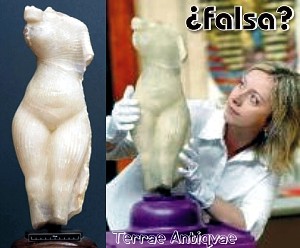Estatua de princesa egipcia podría ser simple falsificación

Una estatua egipcia de alabastro supuestamente del segundo siglo antes de Cristo inspeccionada por expertos en antigüedades y vendida en subasta parece ser producto de un falsificador del siglo XXI.
Inspeccionada por el Museo Británico y vendida a través de Christie's al Ayuntamiento de Bolton, norte de Inglaterra, la estatua de la princesa Amarna, hija del rey Ajenaten y Nefertiti, era supuestamente uno de tres ejemplos de arte egipcio de ese período, informa hoy el diario 'The Times'.
Sospechosamente, la estatua se vendió por una cantidad muy inferior al valor real atribuido por los expertos: unos 640.000 euros en lugar de los 1.5 millones que podían esperarse de ella.
La razón dada para esa ganga era que los misteriosos propietarios de la estatua querían que se quedase en la localidad de Bolton.
Sin embargo, el departamento de Antigüedades de Scotland Yard ha iniciado una investigación después de que el Museo Británico informase de la llegada de un relieve sirio sospechoso.
Los expertos a quienes se pidió tasar el relieve observaron que procedía de una fuente similar a la de la princesa Amarna.
La policía se incautó del relieve y de otros dos objetos en Londres, embargó la supuesta estatua egipcia y llevó a cabo una redada en casa de un vecino de Bolton sospechoso de falsificación.
Según declaró el inspector Martin Freschino al periódico, la casa del individuo parecía un taller: 'Había objetos de mármol y diversos instrumentos para hacer estatuas'.
El sospechoso, de 46 años, y su padre, de 83, están actualmente en libertad bajo fianza aunque tendrán que presentarse a comienzos del próximo mes en la comisaría.
La princesa de Amarna había impresionado a los expertos del Museo Británico y al museo de Bolton por los detalles aportados sobre su procedencia.
El vendedor, que permaneció en el anonimato, dijo que su bisabuelo lo había comprado en una subasta de las propiedades del conde de Egremont en 1892.
Un ejemplar del catálogo de la subasta obtenido por 'The Times' muestra, sin embargo, contiene referencias a 'muebles raros y valiosos' así como a tres lotes donde podría haber figurado la princesa Amarna.
La subasta incluía una estatua de una mujer vestida, cinco estatuillas de mármol y otras ocho figuras vestidas, aunque no se menciona ninguna estatua sin cabeza ni brazos como es el caso de la adquirida por Bolton.
El Ayuntamiento de esta localidad logró, para su compra, el equivalente de 525.000 euros del Fondo Nacional para las Colecciones de Arte y una cantidad más pequeña de los Amigos del Museo y Galería de Bolton.
La estatua de la princesa Amarna, que tiene una altura de 52 centímetros, estuvo incluso expuesta en la galería Hayward de Londres como parte de las celebraciones del centenario de la institución que rescata las obras de arte para el país.
Fuente: Terra Actualidad EFE, 28 de marzo de 2006
Enlace: http://actualidad.terra.es/cultura/articulo/
estatua_princesa_egipcia_podria_simple_803129.htm
----------------------------------
(2) The ancient Egypt statue from Bolton (circa 2003)
By Jack Malvern, Arts Reporter
THEY must have thought they had a bargain: a £1 million artefact carved 3,300 years ago by Ancient Egyptian artisans for just £440,000.
Inspected by the British Museum and sold through Christies, the Amarna Princess was one of only three known examples of the period. The reason for the knock-down price? Its mysterious owners wanted the piece to remain in Bolton.
But a police inquiry now suggests that the alabaster sculpture has less to do with Ancient Egypt and more to do with Bolton circa 2003.
Scotland Yards Arts and Antiques squad began an investigation two weeks ago when the British Museum reported the arrival of a suspicious Syrian relief. Curators who had been asked to inspect the relief for a private client observed that it had come from a similar source to the Amarna Princess. Police seized the relief and two other objects in London and impounded the Princess.
They also raided a house in Bromley Cross, Bolton, where they arrested a 46-year-old man on suspicion of forgery. Acting Chief Inspector Martin Freschini told The Times that the Bolton house resembled a workshop. There were items of marble and ancillary equipment for making statues and the like, he said. We seized a number of items and a quantity of cash.
The arrested mans father, 83, was questioned the next day. The pair are bailed to appear at a Lancashire police station on May 10 and 11.
The Amarna Princess, described as being a representation of the half-sister of King Tutankhamun, had impressed the British Museum and Bolton Museum because of its detailed provenance. The anonymous vendor claimed that his great-grandfather had bought it at the auction of the property of the Earl of Egremont in 1892.
A copy of the Silverton Park auction catalogue obtained by The Times contains very few details of any matching statues. It promised costly, rare and valuable antique furniture, and had three lots that could have been the Amarna Princess. The sale included a draped figure of a female, five marble statuettes and eight Egyptian figures. None mentions that the statue had no head or arms.
This seems to have been convincing enough for Bolton Council, which obtained a grant of £360,000 from the National Heritage Memorial Fund as well as £75,000 from the National Art Collections Fund and £2,500 from the Friends of Bolton Museum and Art Gallery.
The Hayward Gallery, on the South Bank, displayed the statue as part of its Saved! celebration of 100 years of saving art for the nation.
The Amarna Princess is 52cm high and was estimated to be from the 2nd century BC. Experts said that the woman was the daughter of King Akhenaten and Nefertiti, his most senior wife. Akhenaten was succeeded by Tutankhamun, his son by another wife.
Fuente: Copyright 2006 Times Newspapers Ltd. 28 de marzo de 2006
Enlace: http://www.timesonline.co.uk/article/0,,2-2105097,00.html
0 comentarios